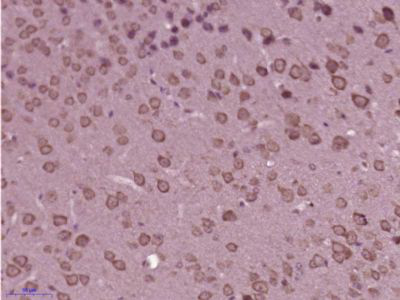产品货号 : mlR12455
英文名称 : PLEKHG5
中文名称 : 凋亡诱导受体PLEKHG5抗体
别 名 : PKHG5_HUMAN; Pleckstrin homology domain-containing family G member 5; PH domain-containing family G member 5; Guanine nucleotide exchange factor 720; GEF720.
研究领域 : 染色质和核信号 信号转导 G蛋白偶联受体 G蛋白信号
抗体来源 : Rabbit
克隆类型 : Polyclonal
交叉反应 : Human, Mouse, Rat, Dog, Pig, Cow, Horse, Rabbit,
产品应用 : ELISA=1:500-1000 IHC-P=1:400-800 IHC-F=1:400-800 ICC=1:100-500 IF=1:100-500 (石蜡切片需做抗原修复)
not yet tested in other applications.
optimal dilutions/concentrations should be determined by the end user.
分 子 量 : 116kDa
细胞定位 : 细胞浆
性 状 : Lyophilized or Liquid
浓 度 : 1mg/ml
免 疫 原 : KLH conjugated synthetic peptide derived from human PLEKHG5:951-1062/1062
亚 型 : IgG
纯化方法 : affinity purified by Protein A
储 存 液 : 0.01M TBS(pH7.4) with 1% BSA, 0.03% Proclin300 and 50% Glycerol.
保存条件 : Store at -20 °C for one year. Avoid repeated freeze/thaw cycles. The lyophilized antibody is stable at room temperature for at least one month and for greater than a year when kept at -20°C. When reconstituted in sterile pH 7.4 0.01M PBS or diluent of antibody the antibody is stable for at least two weeks at 2-4 °C.
PubMed : PubMed
产品介绍 : This gene encodes a protein that activates the nuclear factor kappa B (NFKB1) signaling pathway. Mutations in this gene are associated with autosomal recessive distal spinal muscular atrophy. Multiple transcript variants encoding different isoforms have been found for this gene. [provided by RefSeq, May 2012]
Function:
Guanine nucleotide exchange factor that activates RHOA and maybe the NF-kappa-B signaling pathway. Involved in the control of neuronal cell differentiation. Plays a role in angiogenesis through regulation of endothelial cells chemotaxis.
Subunit:
Interacts with GIPC1/synectin and RHOA.
Subcellular Location:
Cytoplasm. Cytoplasm, perinuclear region. Cell junction. Cell projection, lamellipodium. Note=Predominantly cytoplasmic, however when cells are stimulated found in perinuclear regions. Localized at cell-cell junctions in quiescent endothelial cells, it relocalizes to cytoplasmic vesicle and the leading edge of lamellipodia in migrating endothelial cells.
Tissue Specificity:
Predominantly expressed in the peripheral nervous system and brain. Highest expression is observed in heart, lung, kidney, testis and moderate expression is present in spleen, pancreas, skeletal muscle, ovary and liver. Weakly expressed in glioblastoma (GBM) cell lines.
DISEASE:
Distal spinal muscular atrophy, autosomal recessive, 4 (DSMA4) [MIM:611067]: A neuromuscular disorder. Distal spinal muscular atrophy, also known as distal hereditary motor neuronopathy, represents a heterogeneous group of neuromuscular disorders caused by selective degeneration of motor neurons in the anterior horn of the spinal cord, without sensory deficit in the posterior horn. The overall clinical picture consists of a classical distal muscular atrophy syndrome in the legs without clinical sensory loss. The disease starts with weakness and wasting of distal muscles of the anterior tibial and peroneal compartments of the legs. Later on, weakness and atrophy may expand to the proximal muscles of the lower limbs and/or to the distal upper limbs. DSMA4 is characterized by childhood onset, generalized muscle weakness and atrophy with denervation and normal sensation. Bulbar symptoms and pyramidal signs are absent. Note=The disease is caused by mutations affecting the gene represented in this entry.
Charcot-Marie-Tooth disease, recessive, intermediate type, C (CMTRIC) [MIM:615376]: A form of Charcot-Marie-Tooth disease, a disorder of the peripheral nervous system, characterized by progressive weakness and atrophy, initially of the peroneal muscles and later of the distal muscles of the arms. Recessive intermediate forms of Charcot-Marie-Tooth disease are characterized by clinical and pathologic features intermediate between demyelinating and axonal peripheral neuropathies, and motor median nerve conduction velocities ranging from 25 to 45 m/sec. Note=The disease is caused by mutations affecting the gene represented in this entry.
Similarity:
Contains 1 DH (DBL-homology) domain.
Contains 1 PH domain.
SWISS:
O94827
Gene ID:
57449
Important Note:
This product as supplied is intended for research use only, not for use in human, therapeutic or diagnostic applications.
产品图片












